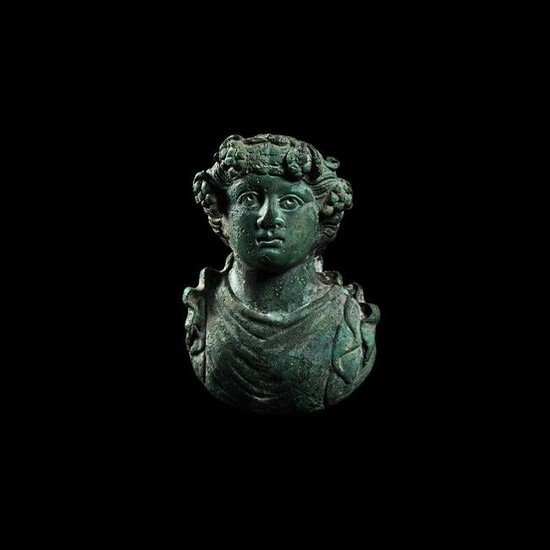Roman Bacchus Chariot Mount
2nd-3rd century AD. A substantial hollow-formed chariot ornament depicting the bust of Bacchus (Greek Dionysus) with clean-shaven face, wearing a wreath of ivy leaves, bunches of grapes in his hair, draped deer skin tied in a knot on his right shoulder, hooves hanging down; rectangular opening in base, circular opening in crown for fixture. See Boucher, S., Inventaire des Collections Publiques Françaises - 17 Vienne: Bronzes Antiques, Paris, 1971; Ratkovi?, D., 'Wagon and Harness Bronzes from the Roman Collection of the National Museum in Belgrade' in Thiasos, Festschrift fur Erwin Pochmarski zum 65. Geburtstag, Wien, 2008, pp.793-815, figs.3-7-8, for similar items; compare also with decorated chariot fittings in Menzel, H., Die römischen Bronzen aus Deutschland III, Mainz am Rhein, 1986, pp.164-177, nn.458-485, especially pls.142-144, for those with the bust of gods; for another possible bust of Bacchus decoration of chariot see Humer, F., Kremer, G., Pollhammer, E., Pülz A., AD 313 Von Carnuntum zum Christentum, Bad Voslau, 2014, n.84. 323 grams, 99mm (4"). Property of an Austrian private collector since the 1970s; accompanied by an archaeological report by Dr. Raffaele D'Amato; this lot has been checked against the Interpol Database of stolen works of art and is accompanied by AIAD certificate number no. 10417-171002. Grave finds of various types, be they travelling carriages, chariots, or two or four wheeled wagons include remains of wood, structural parts such as wheels, as well as metal parts of joins, wagon fittings and harnesses. Bronze figurative decorations on funerary wagons are very often of Dionysiac character and related to Dionysiac mysteries. Hitherto it was a standard approach, for the scholars, to consider the decoration of funeral wagons as exclusively associated with the cult of Dionysus and various themes related to this cult, considering that many of the found chariot fittings were busts of the god himself, Maenads, Satyrs, young men with vine-leaf crowns, or animals, like panthers, linked to his cult. One example similar to this sculpture is the bust of a Maenad in the collection of ancient bronzes of Vienne (Boucher, 1971, cat.42) most probably a chariot decoration as well, like a bust of Dionysus in the same collection (Boucher, 1971, cat.43"). This type of mount was probably used as a bridle holder and placed near the driver’s seat, on the wagon platform or as a central decoration on the back of the wagon.
Condition Report: Fine condition.
View it on
Estimate
Time, Location
Auction House
2nd-3rd century AD. A substantial hollow-formed chariot ornament depicting the bust of Bacchus (Greek Dionysus) with clean-shaven face, wearing a wreath of ivy leaves, bunches of grapes in his hair, draped deer skin tied in a knot on his right shoulder, hooves hanging down; rectangular opening in base, circular opening in crown for fixture. See Boucher, S., Inventaire des Collections Publiques Françaises - 17 Vienne: Bronzes Antiques, Paris, 1971; Ratkovi?, D., 'Wagon and Harness Bronzes from the Roman Collection of the National Museum in Belgrade' in Thiasos, Festschrift fur Erwin Pochmarski zum 65. Geburtstag, Wien, 2008, pp.793-815, figs.3-7-8, for similar items; compare also with decorated chariot fittings in Menzel, H., Die römischen Bronzen aus Deutschland III, Mainz am Rhein, 1986, pp.164-177, nn.458-485, especially pls.142-144, for those with the bust of gods; for another possible bust of Bacchus decoration of chariot see Humer, F., Kremer, G., Pollhammer, E., Pülz A., AD 313 Von Carnuntum zum Christentum, Bad Voslau, 2014, n.84. 323 grams, 99mm (4"). Property of an Austrian private collector since the 1970s; accompanied by an archaeological report by Dr. Raffaele D'Amato; this lot has been checked against the Interpol Database of stolen works of art and is accompanied by AIAD certificate number no. 10417-171002. Grave finds of various types, be they travelling carriages, chariots, or two or four wheeled wagons include remains of wood, structural parts such as wheels, as well as metal parts of joins, wagon fittings and harnesses. Bronze figurative decorations on funerary wagons are very often of Dionysiac character and related to Dionysiac mysteries. Hitherto it was a standard approach, for the scholars, to consider the decoration of funeral wagons as exclusively associated with the cult of Dionysus and various themes related to this cult, considering that many of the found chariot fittings were busts of the god himself, Maenads, Satyrs, young men with vine-leaf crowns, or animals, like panthers, linked to his cult. One example similar to this sculpture is the bust of a Maenad in the collection of ancient bronzes of Vienne (Boucher, 1971, cat.42) most probably a chariot decoration as well, like a bust of Dionysus in the same collection (Boucher, 1971, cat.43"). This type of mount was probably used as a bridle holder and placed near the driver’s seat, on the wagon platform or as a central decoration on the back of the wagon.
Condition Report: Fine condition.



